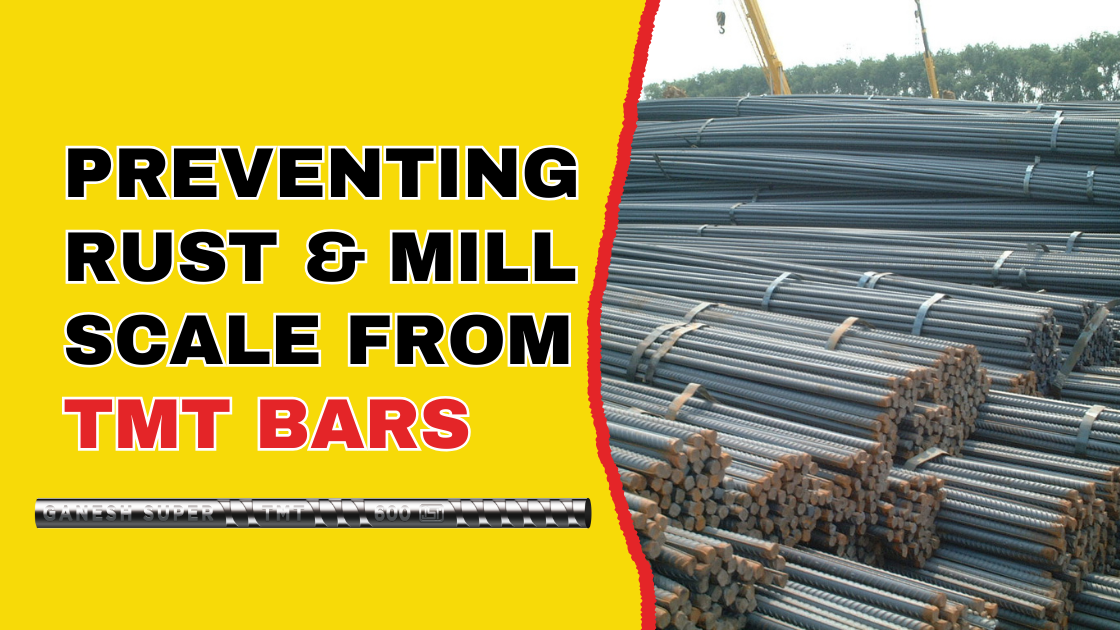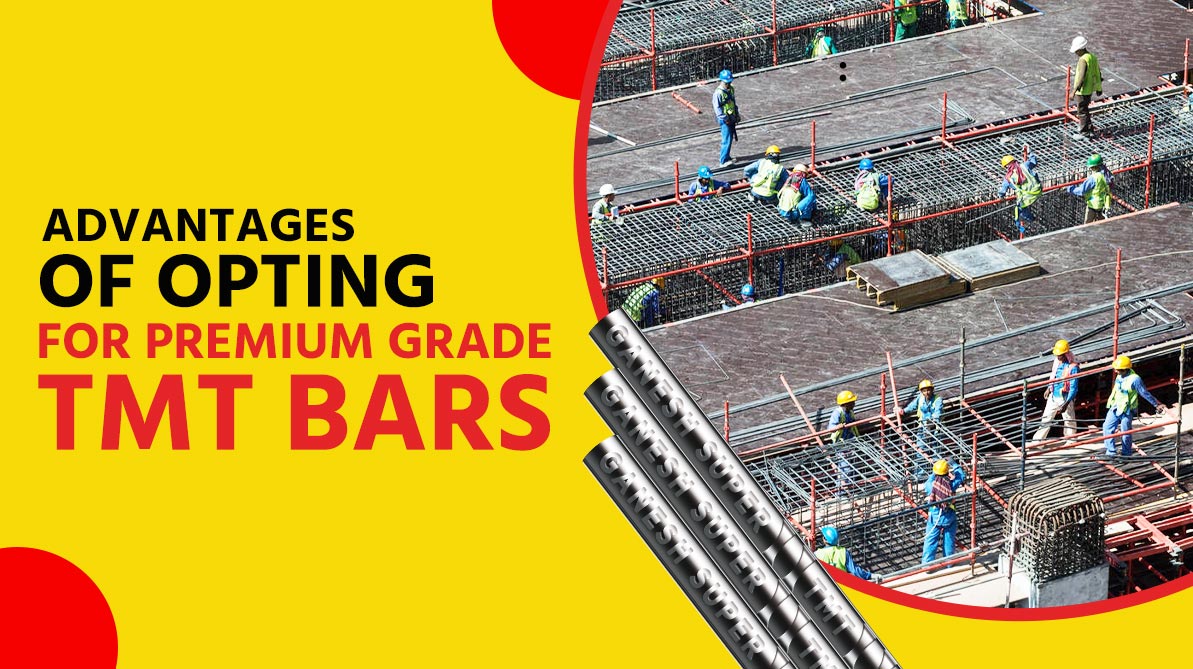Thermomechanically treated bars stand as the backbone of countless structures and stand as the unsung heroes of the construction world. Their strength and resilience form the core of buildings, bridges, and infrastructure projects. However, even TMT bars are not immune to threats like rust and mill scale, which can compromise their integrity and safety. Rust and mill scale not only compromise the aesthetic appeal of the structures but also weaken the bars. This poses a serious safety hazard to the constructed structures. In this blog, you will see the effective methods to prevent their formation on TMT bars and ensure the durability and safety of construction projects.
What Are Rust & Mill Scale?
Rust, scientifically known as iron oxide, is a reddish-brown coating formed on iron or steel when exposed to oxygen and moisture over time. This results in the oxidation of the metal’s surface. It weakens the structural integrity of the TMT bars and can be removed through abrasion or chemical treatment. On the other hand, mill scale is a dark, flaky surface layer comprised of iron oxides, primarily magnetite and wustite. These iron oxides are formed during the hot fabrication process, such as rolling, forging, or welding of steel. While both rust and mill scale are oxides of iron, they differ in their formation processes, appearance, and impact on the TMT bar’s properties. TMT bar suppliers often remove the mill scale before further processing to prevent issues such as surface contamination or impaired weldability.
Effects of Rust & Mill Scale on TMT Bars
Structural Integrity
Rust and mill scale can compromise the structural integrity of TMT bars, especially those that are used in the construction of structures that need to bear heavy loads. Rust formation on the surface of TMT bars indicated corrosion and weakening of the steel, potentially leading to structural failure over time. The mill scale is usually properly removed before usage. It acts as a barrier between the concrete and the steel reinforcement. If not removed properly, it can reduce the bond strength and overall performance of the constructed structure. Regular inspection and maintenance are crucial to address any signs of rust or mill scale on TMT bars to ensure the safety and longevity of the structure.
Corrosion Resistance
The chemical composition and manufacturing process of TMT bars enable them to resist corrosion. However, the presence of rust and mill scale can still accelerate corrosion. This is especially prevalent in harsh environments with high humidity, salt exposure, or chemical pollutants. Rust weakens the protective layer of the steel and makes it more susceptible to further corrosion. Similarly, the mill scale can cause accelerated corrosion in some areas and compromise the durability of the TMT bar. This reduces the lifespan of the concrete structure. Proper surface treatment and corrosion protection measures are essential to reduce the impact of rust and mill scale on TMT bars and ensure long-term performance.
Bond Strength
The impact of rust and mill scale on the surface of TMT bars is more serious than you could have thought. Rust formation creates a rough, uneven surface that diminishes the contact area between steel and concrete. This reduces the bond strength and durability of the TMT bar and concrete and leads to bond failure under loading or environmental stresses. Similarly, the mill scale acts as a barrier that prevents proper adhesion between the TMT bar and concrete mix. It weakens the bond and compromises the structural integrity of the reinforced concrete element. Effective surface preparation techniques, such as mechanical abrasion or chemical treatment, are essential to remove rust and mill scale and promote strong bond development between TMT bars and concrete in construction applications.
Aesthetic Damage
Rust and mill scale not only affect the structural integrity of the TMT bars but also contribute to aesthetic degradation in exposed concrete structures. Rust stains can appear on the surface of the concrete due to the leaching of iron oxide, which detracts from the visual appeal of the structure. Similarly, the presence of mill scale can create an uneven surface texture that affects the overall finish of the concrete surface. The aesthetic damage caused by these elements can diminish the appearance of the structure and may require remedial measures to restore its visual appeal, adding to the overall maintenance costs.
Repair Costs
Addressing the impact of rust and mill scale on TMT bars includes significant repair costs, including surface treatment, corrosion protection, and potential structural rehabilitation. Removing rust and mill scale often requires specialized equipment and techniques. This increases the expenses associated with maintenance and repair. Moreover, if corrosion-related damage is left unchecked, it can lead to more extensive structural issues that necessitate costly repairs or even replacement of affected components. Therefore, proactive measures to prevent rust and mill scale formation, such as regular inspection, surface treatment, and corrosion protection, can help mitigate long-term repair costs and preserve the structural integrity of reinforced concrete structures.
Safety Concerns
Rust and mill scale can significantly reduce the load-bearing capacity and structural stability of TMT bars. This poses significant safety concerns in construction applications, particularly in structures that need to bear heavy loads on a daily basis. Corrosion-induced deterioration weakens the strength og TMt bars and increases the risk of structural failure, particularly under seismic activities. Additionally, the presence of rust and mill scale may conceal underlying defects or structural weaknesses, making it challenging to assess the true condition of the structure. Therefore, proactive maintenance and corrosion management practices are essential to ensure the safety and integrity of reinforced concrete structures and mitigate the risk of accidents or catastrophic failures.
Preventing Rust & Mill Scale on TMT Bars
● Proper storage: TMT bars should be stored in a dry and well-ventilated area to minimize their exposure to moisture. They should be kept off the ground on pallets or racks to prevent direct contact with moisture-laden surfaces.
● Protective Coatings: Applying protective coatings such as epoxy, zinc, or polymer-based paints can effectively shield TMT bars from moisture and oxygen. This prevents rust and mill scale formation on the bars. These coatings provide a barrier against environmental elements and prolong the lifespan of the bars.
● Galvanization: For TMT bars, the step involves coating them with a layer of zinc through a hot-dip galvanizing process. This zinc coating acts as a barrier, preventing moisture and oxygen from reaching the surface of the bars and thus preventing rust and mill scale formation.
● Passivation: it is the chemical process that involves treating the surface of TMT bars with an acidic solution to remove impurities and create a protective oxide layer. This oxide layer acts as a barrier against corrosion, effectively preventing rust and mill scale formation.
● Dehumidification: Installing dehumidification systems in storage facilities can help maintain optimum humidity levels. This reduces the risk of moisture buildup on TMT bars. Dehumidifiers keep the environment dry and create conditions that will prevent rust and mill scale formation.
● Regular Inspection & Maintenance: A periodic inspection of TMT bars is essential to detect any signs of rust or mill scale formation early on. Any areas showing signs of corrosion should be promptly treated and repaired to prevent further deterioration.
The Bottom Line
Preventing rust and mill scale formation on TMT bars is crucial for ensuring the durability and safety of construction projects. Ganesh Super manufactures TMT bars that are made with a special process to prevent rust and mill scale, even under the harshest environmental conditions. By implementing proper storage practices, applying protective coatings, galvanizing, passivation, utilizing dehumidification systems, and conducting regular inspections, TMT bar wholesale dealers can effectively safeguard TMT bars from corrosion. Investing in preventive measures not only enhances the longevity of structures but also minimizes maintenance costs and ensures compliance with safety standards. With proactive measures in place, construction professionals can uphold the integrity of buildings and infrastructure for years to come.





